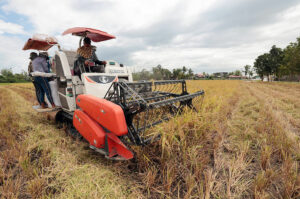
House panel chairman promises RCEF support after rice tariff cut
LEADERS of the House of Representatives said on Thursday that they will continue to support farm modernization despite the potential loss of funding from rice import tariffs, which the government reduced to 15% from 35%.
The Rice Competitiveness Enhancement Fund (RCEF), which finances industry modernization, is by law the recipient of P10 billion a year from rice import tariffs. RCEF tariff support is authorized by the Rice Tariffication Law of 2019.
“Even at the higher allocation of P15 billion for the Rice Competitiveness Enhancement Fund under the House version of the revised (Rice Tariffication Law), we are already assured it will be funded for next year,” Quezon Rep. Wilfrido Mark M. Enverga said in a statement.
Mr. Enverga chairs the House Committee on Agriculture and Food.
The government earlier this week approved a revised tariff program for 2024 to 2028 — which includes a reduction of rice tariffs to 15% from 35%.
The 2019 law liberalized rice imports but charged a 35% tariff on imported grain. The 35% rate originally applied to rice from Southeast Asia, but the government subsequently applied that rate to rice from any country of origin.
“We will make sure that our rice farmers aren’t short-changed in this government effort to bring down the cost of rice,” Mr. Enverga said. “So, even if tariff collection falls short for RCEF allocation, the government will provide funds to fill whatever deficiency to ensure sufficient financing for the Rice Fund.”
Speaker and Leyte Rep. Ferdinand Martin G. Romualdez described the tariff cut as a means of reducing the retail price of the staple. “The reduction in tariffs will make imported rice cheaper,” he said in a briefing.
Well-milled rice prices in late May averaged P48 to P55 per kilo while regular-milled rice sold for P45 to P52, according to Department of Agriculture price monitors.
Mr. Enverga urged the Department of Trade and Industry to monitor the entire rice supply chain to ensure that the benefits of cheaper rice are passed onto consumers and not captured by any one segment of the chain. — Kenneth Christiane L. Basilio



